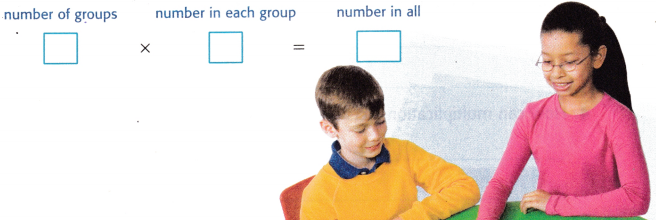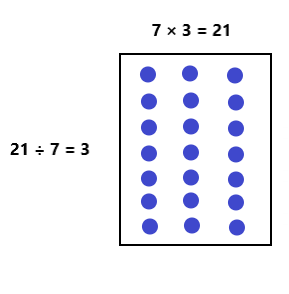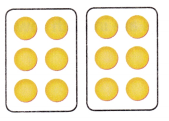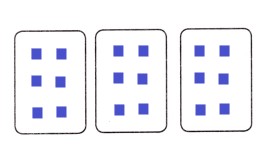All the solutions provided in McGraw Hill Math Grade 3 Answer Key PDF Chapter 5 Lesson 4 Relate Division and Multiplication will give you a clear idea of the concepts.
McGraw-Hill My Math Grade 3 Answer Key Chapter 5 Lesson 4 Relate Division and Multiplication
Division and multiplication are related operations.
Build It
Find 21 ÷ 3.
1. Model 21 counters divided into 3 equal groups. Draw the model. How many counters are in each group?
____ counters
Answer:
7 counters are in each group.
Explanation:
Given,
No of counters = 21
The counters are divided into 3 equal groups.
21 ÷ 3 = 7 counters in each group.
2. Write a division sentence.

Answer:
Dividend is 21, Divisor is 3 and the quotient is 7.
Explanation:

3. Write a multiplication sentence.

Answer:
Number of groups = 3
Number in each group = 7
Number in all = 21
Explanation:
Number of groups × number in each group = Number in all
3 × 7 = 21

Try It
Find 20 ÷ 4.
1. Model 20 connecting cubes divided into 4 equal rows, Draw the model. How many cubes are in each row?
____ cubes
Answer:
20 ÷ 4 = 5 cubes
Explanation:
No of cubes = 20
No of cubes divided into equal rows = 4
20 ÷ 4 = 5 cubes
Therefore there are 5 cubes in each row.
2. Write a division sentence.

Answer:
Dividend = 20
Divisor = 4
Quotient = 5
Explanation:

3. Write a multiplication sentence.

Answer:
4 × 5 = 20
Explanation:

Talk About It
Question 1.
Explain how you used models to show 21 ÷ 3.
Answer:
The models we used here division sentence
21 ÷ 3 = 7
3 × 7 = 21 is called multiplication sentence.
Explanation:
The example figures are
Division Sentence

Multiplication Sentence

Question 2.
Mathematical PRACTICE 6 Explain to a Friend Explain how the array shows that 21 ÷ 3 = 7 is related to 3 × 7 = 21.
Answer:
The array has rows and column
Rows are 21 with three column
Division = 21 ÷ 3 = 7
Multiplication = 7 × 3 = 21
Explanation:

Question 3.
Mathematical PRACTICE 8 Look for a Pattern What pattern do you notice between the number sentences in the two activities?
Answer: A mathematical pattern is a sequence that follows a specific rule. We notice Number patterns between the number sentences in the two activities.
Question 4.
How can multiplication facts be used to divide?
Answer:
In multiplication, the numbers multiplied are called factors. The resultant is called a product.
In division, the number that is being divided is called the dividend, the number that is divided is called the divisor, and the resultant is called the quotient.
Practice It
Write a related division and multiplication sentence for each.
Question 5.

_______
_______
Answer:
12 ÷ 3 = 4
Explanation:
Given
No of counters = 12
No of groups = 3
No of counters in each group = 12 ÷ 3 = 4
The division sentence is 12 ÷ 3 = 4.
The multiplication sentence is 3 × 4 = 12
Question 6.

_______
_______
Answer:
12 ÷ 2 = 6
Explanation:
Given
No of counters = 12
No of groups = 2
No of counters in each group = 12 ÷ 2 = 6
The division sentence is 12 ÷ 2 = 6.
The multiplication sentence is 6 × 2 = 12
Use connecting cubes to solve. Draw your model. Write a division sentence.
Question 7.
Model 10 connecting cubes divided into 2 equal rows. How many cubes are in each row?
Answer:
10 ÷ 2 =5 cubes
Explanation:
No of cubes = 10
No of rows = 2
10 ÷ 2 =5 cubes

Question 8.
Model 6 connecting cubes divided into 3 equal rows. How many cubes are in each row?
Answer:
6 ÷ 3 = 2 cubes
Explanation:
No of cubes = 6
No of rows = 3
6 ÷ 3 = 2 cubes

Algebra Use counters to model each problem. Find the unknown. Then write a related multiplication sentence.
Question 9.
12 ÷ 6 = ![]()
The unknown is _____
Answer:
The unknown is 2.
Explanation:
Given,
12 ÷ 6 = x
x = 2
Question 10.
21 ÷ 7 = ![]()
The unknown is _____
Answer:
3
Explanation:
Given,
21 ÷ 7 = x
7 × 3 = 21
x = 3
The unknown is 3.
Question 11.
25 ÷ 5 = ![]()
The unknown is _____
Answer:
5
Explanation:
Given,
25 ÷ 5 = x
5 × 5 = 25
x = 5
The unknown is 5.
Apply It
Draw a model to solve. Then write a division sentence.
Question 12.
A scientist organizes 14 bugs into 2 equal rows. How many bugs are in each row?
Answer:
14 ÷ 2 = 7
Explanation:
Given,
No of bugs = 14
No of rows = 2
Divide no of bugs by no of rows
14 ÷ 2 = 7
The no of bugs in each row is 7.
Question 13.
A teacher divides her 24 students into 4 equal activity groups. How many students are in each group?
Answer:
24 ÷ 4 = 6
Explanation:
No of students = 24
No of activity groups = 4
No of the students ÷ No of activity groups
24 ÷ 4 = 6
The number of students that are in each group is 6.
Question 14.
Arianna divides 25 gold stars between herself and 4 friends. How many stars does each friend receive?
Answer:
Each friend has 5 stars.
Explanation:
No of gold stars = 25
No of divided by her friends and herself is 5
25 ÷ 5 = 5
No of the stars each friend received is 5.
Question 15.
Mark checked out 12 books from the library. He reads an equal amount of books each week for 4 weeks. How many books does he read each week?
Answer:
12 ÷ 4 = 3 each week.
Explanation:
Number of books from the library = 12
He read an equal amount of books for 4 weeks
12 ÷ 4 = 3 each week.
Hence there are 3 books he read each week.
Question 16.
Mathematical PRACTICE 1 Make a Plan Eli had 20 lemons. He used an equal number in each of 3 pitchers of lemonade. He has 2 lemons left. How many lemons did Eli use to make one pitcher of lemonade?
Answer:
6 lemons.
Explanation:
He used 6 lemons for each pitcher so the answer is 6.
Write About It
Question 17.
How are arrays used in both multiplication and division?
Answer:
An array is used to represent multiplication and division using rows and columns. Here rows represent the number of groups and columns represent the number of each group.
McGraw Hill My Math Grade 3 Chapter 5 Lesson 4 My Homework Answer Key
Practice
Write a related division and multiplication sentence for each.
Question 1.

Answer:
10 ÷ 2 = 5
Explanation:
There are 10 counters given in the diagram.
These counters are divided into 2 groups.
10 ÷ 2 = 5
Hence there are 5 counters in each group.
Question 2.

Answer:
27 ÷ 3 = 9
Explanation:
There are 27 counters that are given in the diagram.
These are divided into equal groups
The no of groups is 3.
These groups are divided into 9 equal counters.
27 ÷ 3 = 9
Problem Solving
Draw a model to solve. Then write a division sentence.
Question 3.
42 students need to divide equally into 7 vans going to the museum. How many students will be in each van?
Answer:
42 ÷ 7 = 6
Explanation:
No of students = 42
No of vans = 7
To find: How many students will be in each van?
42 ÷ 7 = 6
There are 6 students who will be in each van.
Question 4.
Mathematical PRACTICE 4 Model Math Carla is giving out pencils to 30 students. The students are divided equally among 6 tables. How many pencils will Carla leave at each table?
Answer:
5
Explanation:
Given,
No of students = 30
No of the tables that students are divided equally = 6
30 ÷ 6 =5
Carla left with 5 pencils at each table.
Question 5.
Mr. Rina has 7 glass figures. He will use 1 box to mail each glass figure to a customer. How many boxes does Mr. Rina need?
Answer:
7
Explanation:
Given,
Mr. Rina has 7 glass figures.
He used 1 box to mail each glass.
Based on the given question
Let us find out the given question
7 ÷ 1 = 7
Mr. Rina needs 7 boxes.
Vocabulary Check
Use the vocabulary to label each number in the division sentence.
quotient divisor dividend

Answer:
Dividend = The larger number that is separated into smaller groups.
Divisor = The number of groups in which the dividend is separated.
Quotient = This is the answer to the given problem.
Explanation:
